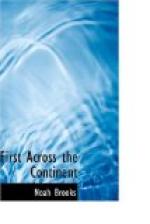The party had missed the Multnomah River in their way down, although this is one of the three largest tributaries of the Columbia, John Day’s River and the Des Chutes being the other two. A group of islands near the mouth of the Multnomah hides it from the view of the passing voyager. The stream is now more generally known as the Willamette, or Wallamet. The large city of Portland, Oregon, is built on the river, about twelve miles from its junction with the Columbia. The Indian tribes along the banks of the Multnomah, or Willamette, subsisted largely on the wappatoo, an eatable root, about the size of a hen’s egg and closely resembling a potato. This root is much sought after by the Indians and is eagerly bought by tribes living in regions where it is not to be found. The party made great use of the wappatoo after they had learned how well it served in place of bread. They bought here all that the Indians could spare and then made their way down the river to an open prairie where they camped for dinner and found many signs of elk and deer. The journal says:—
“When we landed for dinner, a number of Indians from the last village came down for the purpose, as we supposed, of paying us a friendly visit, as they had put on their favorite dresses. In addition to their usual covering they had scarlet and blue blankets, sailors’ jackets and trousers, shirts and hats. They had all of them either war-axes, spears, and bows and arrows, or muskets and pistols, with tin powder-flasks. We smoked with them and endeavored to show them every attention, but we soon found them very assuming and disagreeable companions. While we were eating, they stole the pipe with which they were smoking, and the greatcoat of one of the men. We immediately searched them all, and discovered the coat stuffed under the root of a tree near where they were sitting; but the pipe we could not recover. Finding us determined not to suffer any imposition, and discontented with them, they showed their displeasure in the only way which they dared, by returning in an ill-humor to their village.
“We then proceeded and soon met two canoes, with twelve men of the same Skilloot nation, who were on their way from below. The larger of the canoes was ornamented with the figure of a bear in the bow and a man in the stern, both nearly as large as life, both made of painted wood and very neatly fixed to the boat. In the same canoe were two Indians, finely dressed and with round hats. This circumstance induced us to give the name of Image-canoe to the large island, the lower end of which we now passed at the distance of nine miles from its head.”
Here they had their first full view of Mt. St. Helen’s, sometimes called Mt. Ranier. The peak is in Washington and is 9,750 feet high. It has a sugar-loaf, or conical, shape and is usually covered with snow. The narrative of the expedition continues as follows:—




